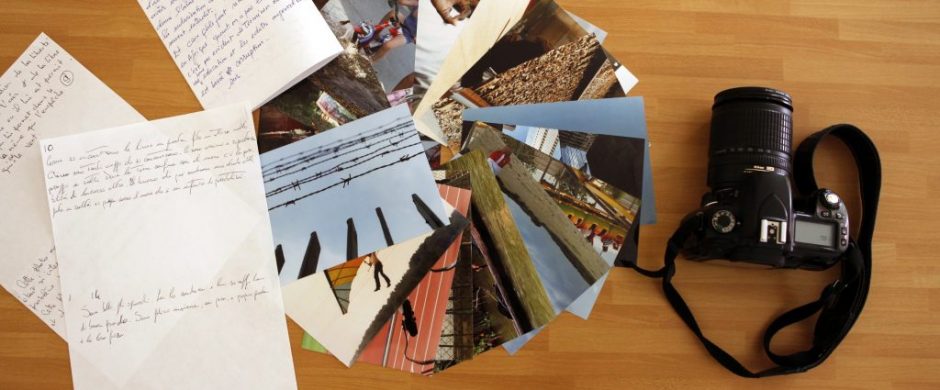
As part of the object-based learning micro-teaching session, I decided to use an archive of photographs depicting animals, landscapes, objects, and scenes from everyday life. The activity was designed for a maximum of six teachers attending the PgCert Academic Practice in Art, Design, and Communication course.
This session aimed to build community and strengthen connections, improve emotional awareness and empathy to reduce social exclusion and conflict and enhance visual literacy skills and imagination. The key methodologies used were:
- Social Action Photography and Therapeutic Photography Techniques: Inspired by Judy Weiser, these methods encourage emotional engagement and meaningful discussions. The activity focuses on identifying challenges and exploring potential solutions to promote well-being and positive change at community, societal, or broader levels.
- Non-Violent communication principles: Drawing on Marshall Rosenberg’s principles, the workshop fostered a respectful and supportive environment for sharing and feedback. These principles enhanced the emotional and creative processes throughout the session.
I learned the Social Action Photography techniques during a course with Judy Weiser and have since had the opportunity to apply and adapt them in various contexts, including in school prisons with under-18 detainees and in hospitals with psychiatric patients. However, this was my first time experimenting with these techniques in an academic setting with colleagues and every time the outcome is different.
Activities
The first activity I introduced was called “Exploring personality and memories”. I placed the photographs on a table, and participants were invited to walk around and select one image that resonated with them. I then guided participants through a reflective exploration of their chosen image, asking questions to help them connect the photograph to their personality, life, or memories. Each participant shared their reflections with the group.
The second activity, “Addressing workplace challenges,” involved participants selecting a second photograph to reflect on the challenges they face in their work environment. I encouraged them to expand the frame of the photographs by imagining additional elements or people that could improve the depicted scenario. This exercise aimed to foster a group discussion about potential solutions to workplace challenges, encouraging a positive and constructive dialogue.
This activity proved to be very powerful, as participants shared deeply personal experiences. One participant selected a picture of a penguin standing alone on an icy landscape, staring at the sea. He explained that this image reflected how he sometimes felt when facing professional challenges alone. When asked to imaginatively expand the picture and introduce positive elements, he visualised a group of penguins emerging from the side of the image, standing on a floating piece of ice, coming to support him.

Another participant chose an image of a typical London bus as a metaphor for the generational gap she feels with her students. “It’s like we are on different floors,” she said, describing her main challenge as a lecturer. This sparked a productive discussion as this was a shared feeling among participants.

A third participant selected an image of an Egyptian painting depicting a person holding a stick to protect a group of small birds from a cat. Through reflection, she associated this scene with the sense of responsibility she feels toward her students, who she perceived as vulnerable and in need of protection. By introducing a symbolic chair into the picture, the interpretation evolved, the chair became a place for the teacher to rest and recharge while the students (birds) gained independence and no longer required constant protection.

Feedback and lessons learned
The feedback on the session was overall positive. Participants described the technique as powerful and emotional, highlighting the use of images as an effective tool for discussing challenges and solutions. One key question that emerged was: If people get emotional how do you handle it?
This was an important consideration, as emotional responses are common in sessions like these. Reflecting on this, I identified a few areas for improvement:
- One mistake I made was not properly introducing the activity due to time constraints. In my session plan, I had written the following introduction:
“Participants will be informed that some questions during the activity may elicit personal emotional responses…(read more in the attachment)
Had I taken the time to explain this at the beginning, participants would have been better prepared for the emotional responses that emerged during the activity. - Another key lesson was the need to stress that emotional reactions, including crying, should not be seen as signs of weakness but rather as expressions of strength and authenticity. In activities like these, emotions are not disruptions but integral parts of the process. The goal is to ensure that discussions occur within a safe and supportive environment, where emotions can lead to positive outcomes rather than discomfort.
- Moving forward, I plan to refine my facilitation approach by integrating clearer grounding techniques at the start and end of the session. Simple strategies, such as breathing exercises or a short reflective pause, can help participants process their emotions in a more structured way.
Overall, this micro-teaching experience was an invaluable opportunity to explore the impact of visual methodologies in an academic setting. It reinforced the importance of preparation, emotional awareness, and the need to create a safe space where participants can engage in deep and meaningful discussions. This session has given me important insights that I will carry forward in my teaching and future participatory workshops.
Bibliography
Hardie, K (2015) ‘Innovative pedagogies series: Wow: The power of objects in object-based learning and teaching’. Available at: https://s3.eu-west-2.amazonaws.com/assets.creode.advancehe-document-manager/documents/hea/private/kirsten_hardie_final_1568037367.pdf (Accessed 15 Feb 2025).
Rosenberg, M.B. (2015) Nonviolent Communication: A Language of Life. 3rd edn. Encinitas, CA: PuddleDancer Press.
Salamon, M. (2018) ‘Drawing Laboratory: Research Workshops and Outcomes’, Spark: UAL Creative Teaching and Learning Journal.
Weiser, J. (1999) Phototherapy techniques: Exploring the secrets of personal snapshots and family albums. Vancouver: Photo Therapy Centre.


